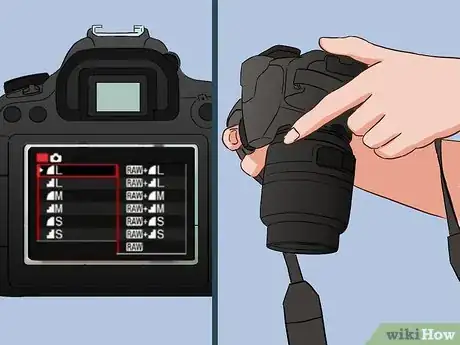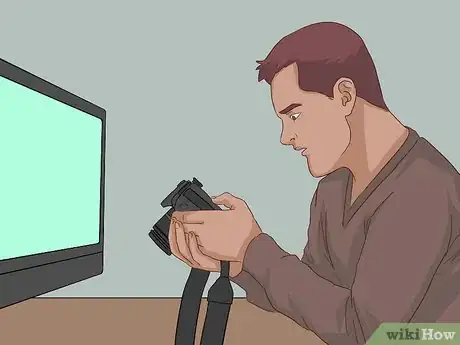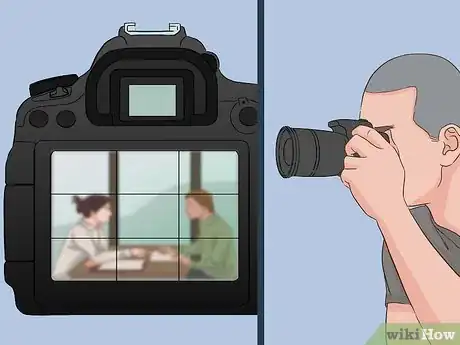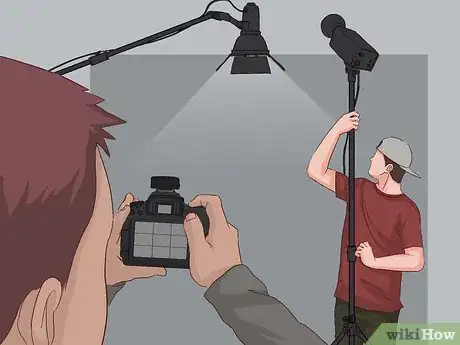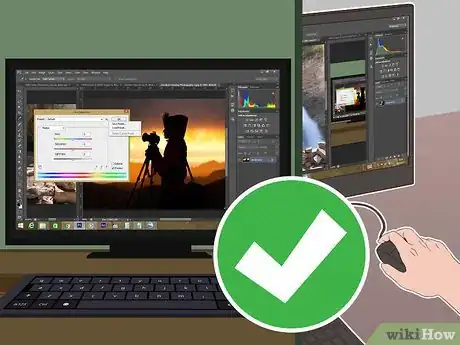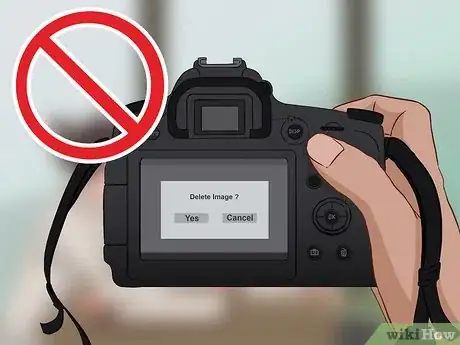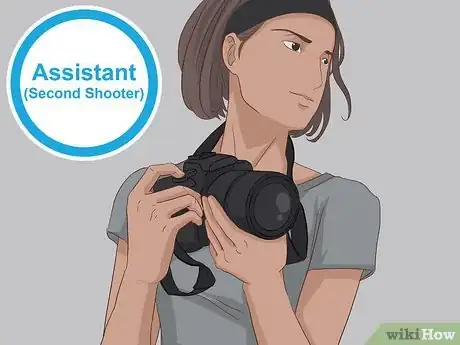This article was co-authored by Richard Engelbrecht. Richard Engelbrecht is a Professional Photographer and the Owner-Operator of Mr.E Photography of Conesus, New York. He specializes in nature photography of the Finger Lakes, Genesee Valley, and Southern-tier regions of New York State.
There are 10 references cited in this article, which can be found at the bottom of the page.
This article has been viewed 24,047 times.
It may seem hard to gain work experience as a photographer, especially when people who hire photographers seem to require prior experience in the first place. While having little experience can pose a challenge to landing a photography gig, it's still possible. Focus on learning about your camera, developing your portfolio, and network your way to success.
Steps
Learning About Your Camera
-
1Learn which file type to use when. The two most common photo file types are JPEG and RAW, with RAW being further divided in M-RAW and S-RAW. Typically, RAW files are larger but have more information, whereas JPEG files are more compressed files that are easier to view. Consider using RAW or one of the RAW modifications if you want to be a professional photographer, as it gives you larger and better-quality images.[1]
- S-RAW and M-RAW offer slight modifications on the RAW file, mostly creating smaller file sizes at the expense of losing resolution.
- You typically can't view RAW files until you upload them to a computer.
-
2Experiment with your camera settings. Become a photography expert by fiddling with your camera and trying every setting. Don't worry about taking bad pictures. Instead, focus on understanding what aperture, shutter speed, and ISO do to a picture.[2]
- Aperture means how large the lens opens during the picture. This affects depth of field and can sharpen or blur your background.
- Shutter speed is how long the camera lens is open and gathering light.[3] Fast shutter speed is good for action shots, while slow shutter speeds require a tripod to take a clean shot.
- ISO determines how sensitive the camera is to light. This controls the exposure of your picture. Increase or decrease your ISO when you're in darker or lighter situations.[4]
- Remember that aperture, shutter speed, and ISO are always connected - if you change one, the other will be impacted by that change!
Advertisement -
3Practice the rule of thirds. Divide the viewfinder into imaginary thirds horizontally and vertically. Your imaginary grid should have nine boxes and four intersection points. Pictures in which the focal point of the image is located at the intersection points tend to be more “interesting” to the human eye. Practice taking shots where the subject of your image is in one of those four intersection points.[5]
- This is not a hard rule, so find what works best for you with practice through trial and error!
-
4Experiment with different lighting styles. Lighting matters, and the “best” light for your photo will change based on what style you're aiming for.[6] Whether you're practicing portraiture, action photography, time lapses, or something else, practice snapping photos in that style and experimenting with your lighting. Take pictures at various different times of day, in the dark, and with flash.[7]
- For examples of different optimal lighting, the “best” light for portrait photos tends to be less “harsh” sunlight from the early morning or late afternoon, while the “best” light for action shots is full sun so you can take quick photos and still have enough light.
- If you can get a friend to come help you, consider purchasing a reflecting board and practice directing and creating your own lighting.
-
5Take lots of pictures whenever you can. As much as you can study and learn the uses of a camera, there are things you won't learn until you physically try them. After you understand how aperture, shutter speed, and ISO impact a picture, practice taking pictures of a waterfall or a sports game and manipulating aperture, shutter speed, and ISO to take crisp, clear photos.
- Invest in a tripod for slower shots like long-exposure or night photography.
Building Your Skills
-
1Develop your portfolio. You'll want a portfolio with a range of styles and an emphasis on quality work. If you can't find any photography jobs, offer to take pictures of your family and friends, and ask them to post them on social media and give you credit. Build a reputation for the types of photography you want to work with.
-
2Pursue a degree in photography. A photography degree will give you job prospects and offer professors and professionals who can help with questions. It will also give you the time and skills to develop a portfolio and dive deeply into the art of photographs.[8]
-
3Learn to use professional photo editing software and techniques. A large part of professional photography is “finishing” the image with professional photo editing techniques. Take a class, try a tutorial, or teach yourself how to use software and finish your photos. Some professional photo editing softwares include Adobe Photoshop, Phase One Capture One Pro, and Serif Affinity Photo.[9]
- Some photographers also like to develop special “trademark” photo editing skills. For example, one photographer could emphasize red tones slightly, while another might take special pride in their ability to merge two images together and create a new art piece.
-
4Don't delete pictures until you get to your computer. During a photography session, you might be tempted to look down at your camera, take a break, and thumb through your pictures. Keep in mind that you're looking at an image on a small screen, and you might be missing the full picture. Wait until you get back to your computer to look at the full picture before deciding to keep it or not.[10]
- Deleting photos on your camera is also not good for the memory stick, as it can cause clutter that slows your memory stick down.
- You can always try to salvage a photo a professional photo editing software.
- Remember: the more time you spend looking down at your camera, the less time you spend looking for a shot.
Expanding Your Network
-
1Treat photography like a business. If you're trying to break into the freelance photography business, don't give away your services for free. Choose whether you want to price your photography per hour or per finished image and set your prices. If you present yourself as a professional, people will see you as one.
- Price for your local market. If you price too high, you might have a hard time finding clients!
- The average price for an amateur photographer in 2017 is between $25 and $100 per hour (amateur photographers generally don't charge per image).[11]
- The average price for a semi-professional photographer that's trying to break into the photography world in 2017 is between $50 and $150 per hour or between $25 and $100 per finished image.
- The average price for professional photographers in 2017 is between $75 and $250 per hour or per finished image.
-
2Develop a website where potential clients can see your work. Make sure your photography website is easy-to-navigate and has portfolio pictures displayed in high resolution. Include an about page so clients can learn more about you and a contact page so they can hire you if they're interested![12]
-
3Become an assistant/second shooter. Often, professional photographers hired to shoot big gigs like weddings will hire a second camera to capture the shots from a different angle. Reach out to local wedding photographers and see if they would like a second shooter for a wedding or a season. Always make sure to follow their rules and maintain professionalism.[13]
-
4Expand your network with social media. When you're a photographer, social media is your best friend. Use social media to post photos online and advertise your business. Keep your social media up to date, and post pictures of the work you're doing, or even give your fans some behind-the-scenes shots. If you take pictures of people, ask them to include your name and website if they post it online anywhere.
- If you are on various different social media platforms, curate your photographs to each platform. For example, you could use Facebook or Instagram for more polished photos, or use Snapchat to show that you're good at composing a shot even without editing it.
Community Q&A
-
QuestionHow can I make my career in photography?
 Richard EngelbrechtRichard Engelbrecht is a Professional Photographer and the Owner-Operator of Mr.E Photography of Conesus, New York. He specializes in nature photography of the Finger Lakes, Genesee Valley, and Southern-tier regions of New York State.
Richard EngelbrechtRichard Engelbrecht is a Professional Photographer and the Owner-Operator of Mr.E Photography of Conesus, New York. He specializes in nature photography of the Finger Lakes, Genesee Valley, and Southern-tier regions of New York State.
Professional Photographer That's really dependent on the type of photography you want to get into, as landscape photography and portrait photography are two totally separate audiences. Common elements among the two would include getting to know other photographers in the area and talking to people, putting yourself out there on Facebook or Instagram, and seeing what kind of response that generates. If you're getting some positive comments, take your work around to local businesses and see if they want to feature some of your local work.
That's really dependent on the type of photography you want to get into, as landscape photography and portrait photography are two totally separate audiences. Common elements among the two would include getting to know other photographers in the area and talking to people, putting yourself out there on Facebook or Instagram, and seeing what kind of response that generates. If you're getting some positive comments, take your work around to local businesses and see if they want to feature some of your local work.
References
- ↑ http://cpn.canon-europe.com/content/education/infobank/image_compression/file_types_raw_sraw_and_jpeg.do
- ↑ http://www.nikonusa.com/en/learn-and-explore/a/tips-and-techniques/a-basic-look-at-the-basics-of-exposure.html
- ↑ Richard Engelbrecht. Professional Photographer. Expert Interview. 1 October 2020.
- ↑ Richard Engelbrecht. Professional Photographer. Expert Interview. 1 October 2020.
- ↑ http://www.travelandleisure.com/articles/in-search-of-the-perfect-shot
- ↑ Richard Engelbrecht. Professional Photographer. Expert Interview. 1 October 2020.
- ↑ http://www.travelandleisure.com/articles/in-search-of-the-perfect-shot
- ↑ https://www.prospects.ac.uk/careers-advice/what-can-i-do-with-my-degree/photography
- ↑ http://www.techradar.com/news/photography-video-capture/cameras/best-photo-editing-software-1284627
- ↑ https://fstoppers.com/wedding/265-tips-becoming-perfect-second-shooter-2719
- ↑ http://www.roshsillars.com/2017/02/much-photographers-charge-2017/
- ↑ https://enviragallery.com/12-mistakes-to-avoid-when-building-a-photography-website/
- ↑ http://www.diyphotography.net/great-photography-debate-gain-experience-without-giving-away-free/
